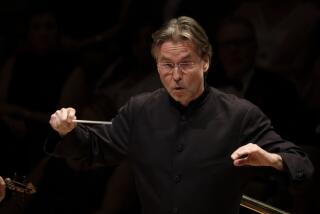Obscure, but oh-so seductive
- Share via
ALARGE Valentine’s Day audience greeted the glamorously clad Czech mezzo-soprano Magdalena Kozena, conductor Bernard Labadie and his hybrid early-music ensemble Les Violons du Roy at Walt Disney Concert Hall on Tuesday night.
Some of the celebrating couples might well have wondered exactly what was in store for them because the program dwelt exclusively upon relatively obscure areas of 18th century French opera and orchestral music that one hardly ever encounters in the concert hall. But Kozena’s remarkable voice, plus the skilled Quebec-based ensemble, put everything over in a bright, seductive, even sensuous manner.
Les Violons du Roy, which has been around since 1984, employs period-performance practices to the hilt: swift tempos, swelling attacks, little or no vibrato. But these musicians produce a far smoother, silkier sound than a typical period band because they use modern instruments, and that is all to the good in a hall like Disney, where they could take full advantage of the resonance and direct projection of sound.
In short, this is a “hybrid” ensemble -- and a most satisfying one. Indeed, Labadie has produced similarly gratifying results when he has guest-conducted local modern-instrument groups such as the Los Angeles Chamber Orchestra.
Kozena, for her part, is a fast-rising star in the classical world. She has built her reputation principally in Baroque repertoire, recorded for Deutsche Grammophon and collaborated with Simon Rattle.
It was obvious within the first five seconds Tuesday that she has a splendid vocal instrument: a gorgeous, polished timbre powerfully projected, with plenty of agility and flexibility. No matter how intense and vehement the emotions in the texts, she radiated a tempering sweetness, with never an ugly or coarse sound.
The announced program was reshuffled so that the concert became a call-and-response game in the first half between instrumental Rameau (two halves of a suite from the opera “Dardanus”) and vocal Gluck (excerpts from “Alceste,” “Armide” and “Iphigenie en Aulide”).
After intermission, in between Kozena’s excerpts from Rameau operas (“Castor et Pollux,” “Hippolyte et Aricie” and two more from “Dardanus,” including her encore) came a lengthy instrumental curiosity, a suite called “Les Elemens” from Jean-Fery Rebel.
The piece is supposed to be a representation of Chaos coalescing into the elements of earth, fire, air and water -- and right off the bat, the orchestra produces some healthy, lusty, amazingly modern-sounding discords. In context with his peers, Rebel was a rebel, all right.
More to Read
The biggest entertainment stories
Get our big stories about Hollywood, film, television, music, arts, culture and more right in your inbox as soon as they publish.
You may occasionally receive promotional content from the Los Angeles Times.










